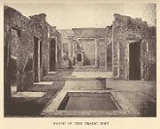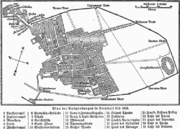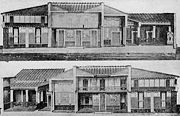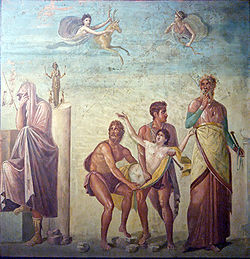
House of the Tragic Poet
Encyclopedia

Pompeii
The city of Pompeii is a partially buried Roman town-city near modern Naples in the Italian region of Campania, in the territory of the comune of Pompei. Along with Herculaneum, Pompeii was destroyed and completely buried during a long catastrophic eruption of the volcano Mount Vesuvius spanning...
, Italy. The house, or villa, is famous for its elaborate mosaic floors and frescoes depicting scenes from Greek mythology.
Discovered in November 1824 by the archaeologist Antonio Bonucci, the House of the Tragic Poet has captivated scholars and writers for generations. Although the size of the house itself is in no way remarkable, its interior decorations are not only numerous but of the highest quality among other frescoes and mosaics from ancient Pompeii. Because of the mismatch between the size of the house and the quality of its decoration, much has been wondered about the lives of the homeowners. Unfortunately, little is known about the family members, who were likely killed by the eruption of Mount Vesuvius in 79 AD.
Traditionally, Pompeii is geographically broken up into nine regional areas, which are then further broken up into insular areas. The House of the Tragic Poet sat in Regio VI, Insula 8, the far-western part of Pompeii. The house faced the Via di Nola, one of Pompeii's largest streets that linked the forum and the Street of the Tombs. Across the Via di Nola from the House of the Tragic Poet sat the Forum Baths of Pompeii.
Layout
Like many Roman homes of the time period, the House of the Tragic Poet is divided into two primary sections. The front, south-facing portion of the house serves as a public, presentation-oriented space. Here, two large rooms with outward-opening walls serve as shops run by the homeowners, or, less likely, as servants quarters. These shops lie on either side of a narrow entranceway, or vestibule. At the end of this hall sits the atrium, the most decorated of the rooms within the House of the Tragic Poet. Here, a large rectangular impluviumImpluvium
The impluvium is the sunken part of the atrium in a Greek or Roman house . Designed to carry away the rainwater coming through the compluvium of the roof, it is usually made of marble and placed about 30 cm below the floor of the atrium.The name is also used for a type of dwelling typical of...
, or sunken water basin sits beneath an open ceiling, collecting water to be used by members of the household. Near the northern end of the impluvium sits a wellhead to be used for drawing water from the basin. Still farther from the entrance sits the tablinum
Tablinum
In Roman architecture, a tablinum was a room generally situated on one side of the atrium and opposite to the entrance; it opened in the rear on to the peristyle, with either a large window or only an anteroom or curtain...
, a second, open common area.
From these main areas extend smaller, private rooms, marking the second section of the house. Along the western wall of the atrium lie a series of cubicula, or bedrooms. Opposite these lie an additional cubiculum, an ala (a service area for a dining room), and an oecus (a small dining area). The northern end of the tablinum opens onto a large, open peristyle
Peristyle
In Hellenistic Greek and Roman architecture a peristyle is a columned porch or open colonnade in a building surrounding a court that may contain an internal garden. Tetrastoon is another name for this feature...
, or garden courtyard. To the west of the peristyle sits the drawing room, which, in the House of the Tragic Poet, is believed to have been used as the main dining salon. Adjacent to the drawing room is a small kitchen area. Near the east end of the peristyle, a small back door opens onto an additional street. Finally, into north-western corner of the peristyle is built a small lararium, or shrine to be used in worshiping the Lares Familiares
Lares Familiares
Lares Familiares were household tutelary deities of ancient Roman religion. The singular form is Lar Familiaris....
, or family gods.
Although records and archaeological experts have confidently confirmed the existence of an upper story in the House of the Tragic Poet, little is known about its specific layout, as it was most likely destroyed by the eruption of Mount Vesuvius.
Vestibule


Beware of the Dog
"Beware of the Dog" is a song written by Jamelia, Stuart Crichton, Tommy Lee James, Karen Poole and Martin Gore, produced by Crichton for Jamelia's third album Walk with Me...
”. These words, much like similar signs today, warned visitors to enter at their own risk and served as protection over the more private quarters of the home. The rest of the vestibule floor was decorated in a tesserae or checker-like pattern, in black and white tiles. This pattern was framed by a border of two black stripes that surrounded the room.
Atrium
The atrium was the focal point of art in the House of the Tragic Poet. After the House of the Vettii, it contained more large-scale, mythological frescoes than any other home in Pompeii. Each image was approximately four feet square, making figures slightly smaller than life-size. The images in the atrium frequently feature seated men and women in movement. The women are usually the focus of the images, undergoing important changes in their lives within the storylines of the famous Greek myths.On the south wall of the atrium were two images—one of Zeus
Zeus
In the ancient Greek religion, Zeus was the "Father of Gods and men" who ruled the Olympians of Mount Olympus as a father ruled the family. He was the god of sky and thunder in Greek mythology. His Roman counterpart is Jupiter and his Etruscan counterpart is Tinia.Zeus was the child of Cronus...
and Hera
Hera
Hera was the wife and one of three sisters of Zeus in the Olympian pantheon of Greek mythology and religion. Her chief function was as the goddess of women and marriage. Her counterpart in the religion of ancient Rome was Juno. The cow and the peacock were sacred to her...
on Mount Ida
Mount Ida
In Greek mythology, two sacred mountains are called Mount Ida, the "Mountain of the Goddess": Mount Ida in Crete; and Mount Ida in the ancient Troad region of western Anatolia which was also known as the Phrygian Ida in classical antiquity and is the mountain that is mentioned in the Iliad of...
and another of Aphrodite
Aphrodite
Aphrodite is the Greek goddess of love, beauty, pleasure, and procreation.Her Roman equivalent is the goddess .Historically, her cult in Greece was imported from, or influenced by, the cult of Astarte in Phoenicia....
(now almost entirely destroyed). The image of Zeus and Hera celebrates a woman’s loss of virginity—a transition from youth to womanhood—as Hera’s veil is clearly removed from her head, symbolically exposing her face. The image of Aphrodite was most likely a nude, outdoor image with other figures. Many scholars agree that the image was probably a representation of the Judgment of Paris. The image of Zeus and Hera is part of the collection at the Archaeological Museum in Naples, Italy.
Along the east wall are scenes of Achilles
Achilles
In Greek mythology, Achilles was a Greek hero of the Trojan War, the central character and the greatest warrior of Homer's Iliad.Plato named Achilles the handsomest of the heroes assembled against Troy....
and Briseis
Briseis
Brisēís was a mythical queen in Asia Minor at the time of the Trojan War. Her character lies at the center of a dispute between Achilles and Agamemnon that drives the plot of Homer's Iliad.-Story:...
and of Helen and Paris. In the first image, Achilles is seen releasing Briseis to the Greek king Agamemnon, who removes her veil to show her weeping face. In the second image, Helen boards ship to travel back to her homeland of Troy. Although no longer in the image, it is believed that Paris was already seated in the boat as Helen boards. Both of these images are part of the collection at the Archaeological Museum in Naples.
The west wall of the atrium shows images of Amphitrite
Amphitrite
In ancient Greek mythology, Amphitrite was a sea-goddess and wife of Poseidon. Under the influence of the Olympian pantheon, she became merely the consort of Poseidon, and was further diminished by poets to a symbolic representation of the sea...
and Poseidon
Poseidon
Poseidon was the god of the sea, and, as "Earth-Shaker," of the earthquakes in Greek mythology. The name of the sea-god Nethuns in Etruscan was adopted in Latin for Neptune in Roman mythology: both were sea gods analogous to Poseidon...
and of Achilles and Agamemnon
Agamemnon
In Greek mythology, Agamemnon was the son of King Atreus and Queen Aerope of Mycenae, the brother of Menelaus, the husband of Clytemnestra, and the father of Electra and Orestes. Mythical legends make him the king of Mycenae or Argos, thought to be different names for the same area...
. The first image, sometimes informally called the abduction of Amphitrite, shows Eros
Eros
Eros , in Greek mythology, was the Greek god of love. His Roman counterpart was Cupid . Some myths make him a primordial god, while in other myths, he is the son of Aphrodite....
and Poseidon fighting, with multiple nymphs surrounding and nude. The second, known as the Wrath of Achilles, depicts the storyline of the Iliad, with Achilles angered from losing Briseis.

Tablinum
The tablinum floor, like that of the vestibule, was decorated with an elaborate mosaic image. Here, actors gather backstage preparing for a performance, as one character dresses and another plays a flute. Other characters surround a box of masks to be used during the performance. Because this mosaic is the centerpiece of the room and therefore seemingly important, modern archaeologists came up with the name "House of the Tragic Poet" to describe the entire villa.Peristyle
The semi-outdoor peristyle area featured an imaginary garden scene or paradeisos in the trompe-l'œil style. This image, it is assumed, was intended to blend in with the actual garden that would have grown within the unroofed portion of the peristyle. To the left of the peristyle was a fresco known as the Sacrifice of Iphigenia, in which Iphigenia is taken by UlyssesOdysseus
Odysseus or Ulysses was a legendary Greek king of Ithaca and the hero of Homer's epic poem the Odyssey. Odysseus also plays a key role in Homer's Iliad and other works in the Epic Cycle....
and Achilles to be sacrificed just before Artemis
Artemis
Artemis was one of the most widely venerated of the Ancient Greek deities. Her Roman equivalent is Diana. Some scholars believe that the name and indeed the goddess herself was originally pre-Greek. Homer refers to her as Artemis Agrotera, Potnia Theron: "Artemis of the wildland, Mistress of Animals"...
delivers a deer to be sacrificed in her place.
Scholarly interest
Because so little is known about its owners yet such a wealth of scenes from Greek mythology were found inside it, the House of the Tragic Poet has served as the focus of many works of fiction and poetry. Among the more famous works is Lord Edward Bulwer Lytton's The Last Days of PompeiiThe Last Days of Pompeii
The Last Days of Pompeii is a novel written by the baron Edward Bulwer-Lytton in 1834. Once a very widely read book and now relatively neglected, it culminates in the cataclysmic destruction of the city of Pompeii by the eruption of Mount Vesuvius in AD 79.The novel uses its characters to contrast...
, in which the author invents the personal life of the owner but rather accurately describes the house's details. Another well-known work is Vladimir Janovic's The House of the Tragic Poet, an epic poem imaged from the mosaic and fresco images throughout the villa.
Art historians and Classics scholars have long been fascinated by the House of the Tragic Poet because of the unique way in which it juxtaposes images from different periods and locations throughout mythological Greece. No single angle within the villa allows one to view all of the images present. Instead, one is required to move around the villa, looking at different combinations of pieces. This logistical fact allows viewers to draw on larger themes of Greek mythology, especially on the relationships between the powerful men and women and also the deities of ancient Greece.

